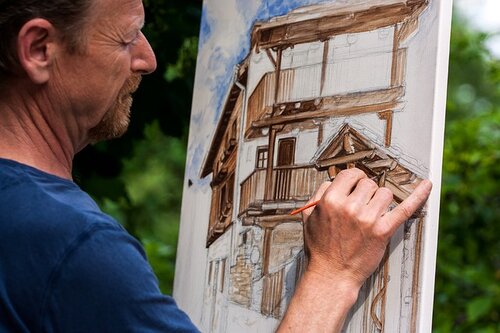by Carolyn Edlund
Price your art to reflect it’s value in the marketplace and pay yourself a profit.

Correct pricing separates the amateur from the professional artist. As an amateur, you may simply hope to make enough to replenish materials, or operate through guesswork. But if you continue to use this approach to pricing when you enter marketplace as a professional, you may run into serious problems. You may end up seriously undercutting the competition by pricing too low, making life difficult for those around you at retail shows and fairs.
At the same time, you will shoot yourself in the foot by not charging enough to keep your business alive—including the important task of paying yourself a salary. Pricing like an amateur is a really good way to go broke!
There is a simple formula for pricing your work correctly, starting with calculating the wholesale price of your work:
Materials Costs + Labor Costs + Overhead + Cost of Sale + Profit = Wholesale Price
Refer to this pricing article which gets down into the details of each one of these items and how to arrive at a bottom line, or “floor” for the price of your work. This is foundational, because it puts you in the position of understanding your costs and staying right-side up. When you know your recurring costs and how to arrive at profitable prices, you can create shortcuts to quickly calculate a price on the spot. This might take the form of pricing per square inch, for example.
How can you as the artist use the “wholesale” price you arrive at in the above formula? Once calculated, that price may confidently be charged when making an outright sale of product to a retailer (which is in fact the wholesale model.) You’ll know that you have a profit margin built in and you are earning rather than losing money.
That same figure may also represent the artist’s share of work sold on consignment in a gallery or shop, since typical commissions run around 50%. And if you are retailing, charge a markup of at least 100% to retain consistent pricing and avoid undercutting resellers.
This formula is a useful guide to help you navigate the waters toward accurate pricing. It uses a left-brained approach to ensure that the math adds up and you aren’t losing money. But that’s not the whole picture when it comes to determining the correct price. There are other factors at play that affect the market price of your work.
Perceived Value
Collectors evaluate the worth of their purchases in aesthetic terms such as beauty, craftsmanship and quality. They also estimate worth in personal terms, such as the perceived value and benefits of a particular object. These are both right-brained approaches to purchasing and pricing.
Both of these approaches are correct and useful, and each serves its own purpose. While the left-brained approach keeps you focused on time, efficiency and cost, the right-brained approach keeps you looking for new ways to enhance quality and add value without significantly increasing those costs.
Set your prices and keep them consistent. Over time, keep track of sales and how quickly you are turning over new work. Slow sales may be a reason to step back and reevaluate why; it may be a pricing issue, or something else. When your work is selling regularly with continued demand, you will have reached an equilibrium in your pricing, which is a sweet spot. As your art and your business matures, you should be able to gradually increase prices while retaining or even growing the number of sales.
Pricing E-Course
Our online comprehensive course Pricing Strategies for Artists & Makers helps creative entrepreneurs understand the entire pricing process and confidently.




Speak Your Mind